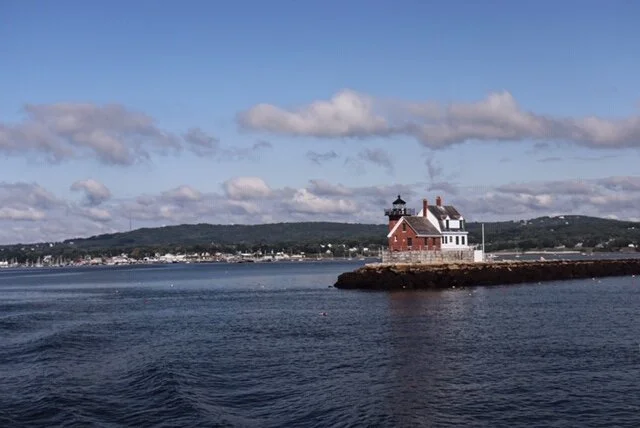Growing Oysters in Oyster Nirvana: The Story of North Haven Oyster Co
Adam, his entire family, and those assisting the Campbell’s on their oyster farm, share an exuberant passion for aquaculture. Adam was excited to share the history of North Haven Oyster Company, as well as how he farms his prized oysters.
If you’re setting out to North Haven Island to try its revered oysters, you better be ready for an adventure. The journey to North Haven begins with a twelve mile ferry ride on the Captain Neil Burgess across the Penobscot Bay from Rockland. Travel in the sunlight, and you will see tourists clamoring to the top of the ferry, hurriedly snapping photos of the blue Camden Hills which provide a lovely backdrop to the rolling aquamarine ocean waters. Travel in the fog, and your journey will venture into the steel gray abyss, where whole islands are swallowed up by the clouds within seconds. Whatever the weather conditions, the one hour journey to North Haven is only the start of the adventure.
North Haven is one of Maine’s fourteen unbridged island communities. At just under twelve square miles, the island has a year-round population of 355 people. The island was inhabited as early as 3300 B.C. by a tribe known as the Red Paint People—Pre-Algonkians who grew to inhabit much of Maine. In fact, oyster shells dating back thousands of years have been found on North Haven – evidence that the Red Paint People had long been consuming the wild oysters from those waters. Native Americans and Europeans fished North Haven’s surrounding waters, and in the second half of the 19th century, clamming and lobstering became prominent.
North Haven is blessed with open, rolling fields, soaring pine trees, and a picturesque main village that sits on a thoroughfare across from the neighboring island of Vinalhaven. The south side of the island is home to the ferry dock, the island’s historical center, a small brewery, and a family-run boatyard founded in 1888.
As you travel up Main Street, away from the ferry dock, and into the heart of the island, handwritten signs advertising oysters begin popping up at intersections. It becomes an exciting scavenger hunt through the winding, picturesque North Haven roads to find the promised bivalves. The trail ends at Middle Road, at the “oyster nirvana” that is North Haven Oyster Company, owned by Adam Campbell.
The History of North Haven Oyster Company
The official North Haven Oyster Company signage, greeting oyster fans to Adam’s lease site on Middle Road.
Adam Campbell will tell you that his wife can trace her ancestry on North Haven back over two hundred years. In fact, Adam’s wife was related to Hiram “Hightie” Beverage, who built a dam on a nearby freshwater stream, and unknowingly changed the course of oyster history. The environment and history of North Haven Oyster Company is as rich as that of the island of North Haven.
The location of the North Haven Oyster Company farm is crucial to the flavor of its oysters, as well as the success of the farm. Adam Campbell leases over 16 acres of the subtidal waters of the Mill Stream and Hightie’s Pond. The Mill Stream is a body of water which flows in an East-West direction from Pulpit Harbor on the Penobscot Bay. At high tide, the salty Atlantic waters surge westward into the Mill Stream, turning it brackish. Historically, several dams were built along the freshwater stream to utilize the power of the ebb and flow of the tides to generate power for three local mills. The present-standing dam was built in 1932 by Hiram “Hightie” Beverage. When the current dam was originally built, it was with the understanding that a culvert would be part of the construction to serve as a “fishway” so that alewives could spawn in the pond created by the dam.
A little bit of science goes into understanding why Adam Campbell’s aquaculture lease site is so optimal for oyster growth. Bivalves thrive exceptionally well in estuarine bodies of brackish water—meaning a mixture of salt and freshwater. In a perfect oyster environment, the oysters would grow in a pond that remains brackish year-round, without salinity levels fluctuating with the tides.
Crucial to North Haven Oyster’s success is the dam built by Hightie Beverage. The porous dam allows for brackish waters—a mixture of briny Atlantic Ocean water and fresh Mill Stream water—to flow through the dam and create a pond that remains brackish year-round. This pond is now known as Hightie’s pond. Typically, at low tide, the ocean water would rush back out of the Mill Stream and the salinity of the water would drop. However, because a dam was built, this prevents the pond from fully draining at low tide, and allows it to remain brackish year-round. Even more beneficial, the sediment of Hightie’s pond, as well as Mill Stream, is a mixture of rock and clay—the perfect combination on which to bottom-plant growing oysters.
The immense benefits of the Mill Stream and the fateful dam went unknown to the Campbell’s for quite some time. In fact, Adam first learned about his property’s potential for an “oyster nirvana” in a nonchalant conversation with a biologist in the mid-1990’s. Historically, North Haven used to be the home of a massive smelt population. For some unknown reason, smelts left the area. A biologist was hired to evaluate the issue. The plan was to place burlap sacks at the bottom of Penobscot Bay, near the mainland, where smelt spawned, and to then take the burlap sacks containing the smelt eggs back to the North Haven waters, where the smelt would hatch. Unfortunately, the plan didn’t work. The same biologist was asked to return to North Haven and assess the island for other potential areas of promising aquaculture. In an off-the-cuff conversation, the biologist remarked to Campbell that Hightie’s Pond appeared to be an optimal setting for an oyster farm due to its brackish waters.
This casual observation piqued Campbell’s interest. Campbell, a lobsterman, researched the area a bit more in an effort to assess the biologist’s observation. After doing his due diligence, Adam treated himself to 300,000 oyster seed on his 36th Birthday. Since 1999, North Haven Oyster Company has existed and has grown into the legend it is today.
Raising Oysters in Oyster Nirvana
During my North Haven journey, I had the opportunity to meet Adam and sneak a peak of his oyster operations. Adam, his entire family, and those assisting the Campbell’s on their oyster farm, share an exuberant passion for aquaculture. Adam was excited to share the history of North Haven Oyster Company, as well as how he farms his prized oysters.
Visitors can walk right up the “oyster shack” on Adam’s family’s property, and chat with Adam and the crew themselves when they are not out tending to the oysters. North Haven Oyster Company also boasts its now-famous refrigerator, where bivalve curious customers can pick up a dozen or so of the freshly-harvested North Havens. If Adam and company are not on site, Adam uses an honor system for his hungry customers. The oyster shack itself is an eclectic collection of maritime memorabilia, funky artwork, and oyster shells - proof that Adam and his team are more than happy with the tasty product they produce.
Adam purchases his oyster seed from Muscongus Bay Aquaculture. In May, Adam places his oyster seed in upwellers in Hightie’s Pond, which are powered by 220 volt electric motors. The upwellers provide a ceaseless supply of phytoplankton on which the oysters feed; the upwellers also clean the baby oysters, and prevent fouling. In roughly two weeks, the baby oysters grow to approximately five times their size, and are able to be moved from the upwellers. Adam measures the babies every couple of days, and separates them according to size.
The young oysters are then placed in bags, which are deployed on the western side of the porous dam. The oysters remain in these bags for the remainder of the summer, through the following June. Because Hightie’s Pond does not entirely freeze over, the bags can be placed at the bottom of the pond for over-wintering. The next year, Adam removes the oysters from the bags, and plants them—cageless and bagless—at the bottom of Hightie’s Pond. This technique is used by only a few oyster farmers throughout the world, and is attributable solely to North Haven Oyster’s location. When the tides are low, Adam is able to wade through the water, and check on his oysters. Campbell’s oysters grow, bottom-planted, with the daily cold ocean tides flowing over the oysters, bringing them nutrients, and marinating them in the brackish waters. At three years of age, Adam and his team are able to harvest his oysters in the subtidal channels of the stream by hand.
North Haven Oysters
Physically, the most unique characteristic of the North Haven oyster is its striking, mossy green goose-footed shell. Oyster shells are porous, and thus, their shell color is a manifestation of their marine environment. Because North Haven oysters are grown in shallow water, their porous shells absorb regular sunlight, they are exposed to sunlight year-round, which turn their shells green.
North Haven oysters are 3 inch, deep cupped and strong-shelled beauties. Their flavor profile is complex, with a balanced brine, and sweet-cream richness. The oysters are available year-round, but are recommended in late fall through winter, as their salinity is high during the winter months.
For more information on North Haven Oyster Company, check out their website!









